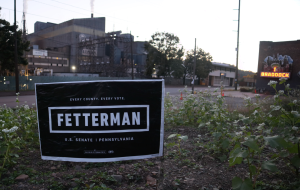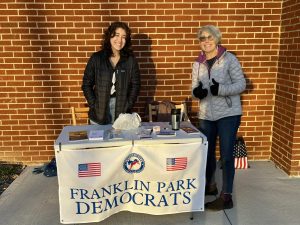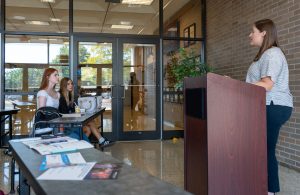Students react to the Pennsylvania midterm elections
With control of both the House and Senate still up in the air, NASH seniors reflect on voting in their first election.
Campaign signs sit outside of the polls at Northmont Presbyterian Church.
November 10, 2022
November 8th has now passed, and months on the campaign trail–with billions of dollars spent on an endless barrage of advertising–have finally come to an end. Midterm elections are often described as a referendum on the party in power, and history suggested that Democrats would endure losses due to the rising concern of high inflation. However, the anticipated “red wave” in the US House of Representatives failed to fully materialize, and the likelihood of Republicans flipping enough Senate seats to hold a majority is also still considered a toss-up.
Most notably for NASH, this was the first election in which seniors who recently turned 18 were able to participate, and it was a rare occasion where races for PA governor and a US Senate seat occurred in the same year.
“Even though my political views are different from those of my parents, it’s important to participate in democracy,” senior Savannah Guzzi-Graber told The Uproar.
Pennsylvania Attorney General Josh Shapiro easily won the Pennsylvania governorship, beating Republican state senator Doug Mastriano with 56 percent of the vote. While the outcome of the gubernatorial race was widely expected, the issues at stake ranged from critical race theory to the preservation of free elections, as the PA governor appoints the secretary who is responsible for certifying the state’s voting machines.
Some NASH students are thrilled with Shapiro’s victory.
“I’m happy that Josh Shapiro won, as I agree with his pro-choice stance on abortion,” senior Jules Romanelli said.
The most watched race in Pennsylvania was the competition for US Senator between Republican Mehmet Oz and Democrat John Fetterman. In Braddock’s 2005 mayoral election when Fetterman took public office for the first time, a single tie-breaking vote granted him the victory, but this year, approximately 200,000 votes gave Fetterman the majority over Oz. Even so, his victory over Oz was a close one, as Fetterman gained just over 50 percent of the vote.
One student, who asked to remain anonymous, was disappointed that Oz lost the seat but was confident in the election’s validity.
“I’m surprised and disappointed that Fetterman won,” the student said. “While I believe that there were some irregularities that affected the 2020 election, I think that most of them were fixed for this election.”
Though reporters closely followed the battle for the Pennsylvania Senate seat, the outcome of the balance of power in that chamber of Congress is still undecided, with four seats left to be called, including a runoff election in Georgia.
The Biden administration depicted this year’s midterms as a test of American democracy, but more Americans were directly motivated by inflation than this call to action. According to one Gallup poll conducted in September, 20 percent of Americans believe inflation is the primary issue facing the country, while four percent believe the soundness of American democracy is of foremost concern.
“Inflation was the issue I based my vote on because it affects everybody,” senior Luke Demi said.
Young voters have been increasingly active in recent years, and that trend continued with this year’s election. In 2018, the year of the previous midterm election, 41 percent of 18-to-40-year-olds turned out to the polls, compared to only 26 percent in 2014.
Four years after the decisive 2018 midterms, expected voter turnout remained strong. According to a survey conducted in October, 43 percent of young adults said they definitely planned to vote.
The well-known Senate and governor races dominated the media, yet there were also important races for seats in the US House of Representatives. Democrat Chris Deluzio and Republican Jeremy Shaffer competed to represent Pennsylvania’s 17th Congressional District, which sweeps over Pittsburgh’s North Hills. Deluzio won the seat with 53 percent of the vote.
Outside of the North Hills, the race for the 12th Congressional District was closely watched in the Mon Valley southeast of Pittsburgh, even as the City of Pittsburgh has had no GOP Congressional representation since 1953. Democrat Summer Lee held a tight lead over Republican Mike Doyle throughout her campaign. She won the seat with 56 percent of the vote, making her the first black woman to represent PA in Congress.
Often overlooked, local representatives have a more direct effect on the day-to-day lives of their area’s residents, as they represent our neighborhoods in the state legislature.
Most North Allegheny residents live in District 30 of the Pennsylvania House of Representatives, where Democrat Arvind Venkat won against Republican Cindy Kirk. Both candidates have necessarily strong local ties, as Venkat has children who attend North Allegheny, and Kirk once served on the board at Northland Public Library.
When it comes to Pennsylvania’s influence on national politics, this year’s midterms were the most consequential in years. John Baick, a political scholar at Western New England University, offered some startling insight.
“Pennsylvania is deciding which direction we go, which direction the planet goes,” he said just prior to the election.
For NASH seniors who have finally reached voting age in an era flooded with divergent political opinions, at least one thing can be agreed upon: their inaugural election was by no means insignificant for the future of America.
“While I’d like to say that every election matters, this one was particularly significant, given the current state of the US Senate where every seat matters,” said Mr. Maddix, AP US Government teacher.















